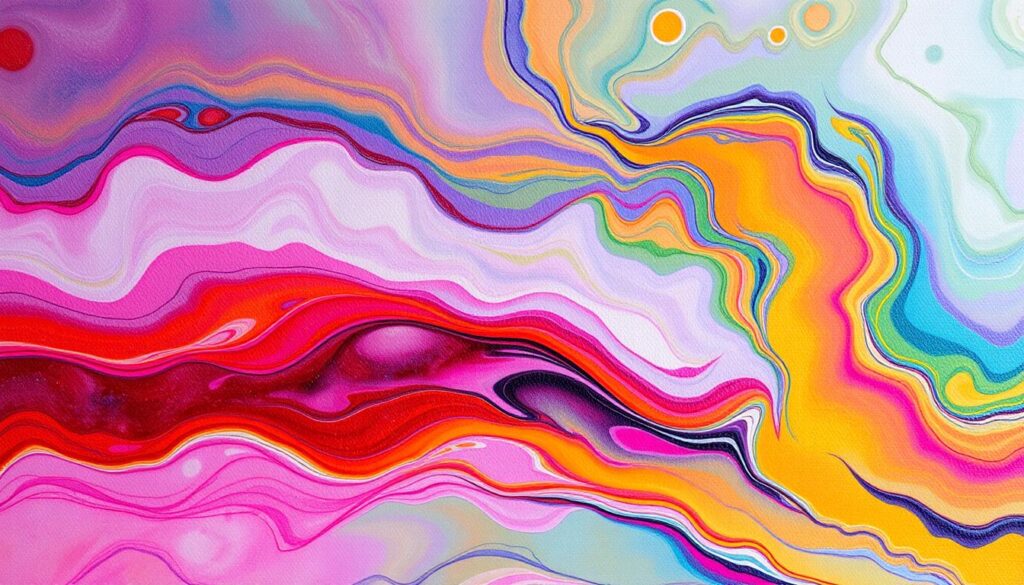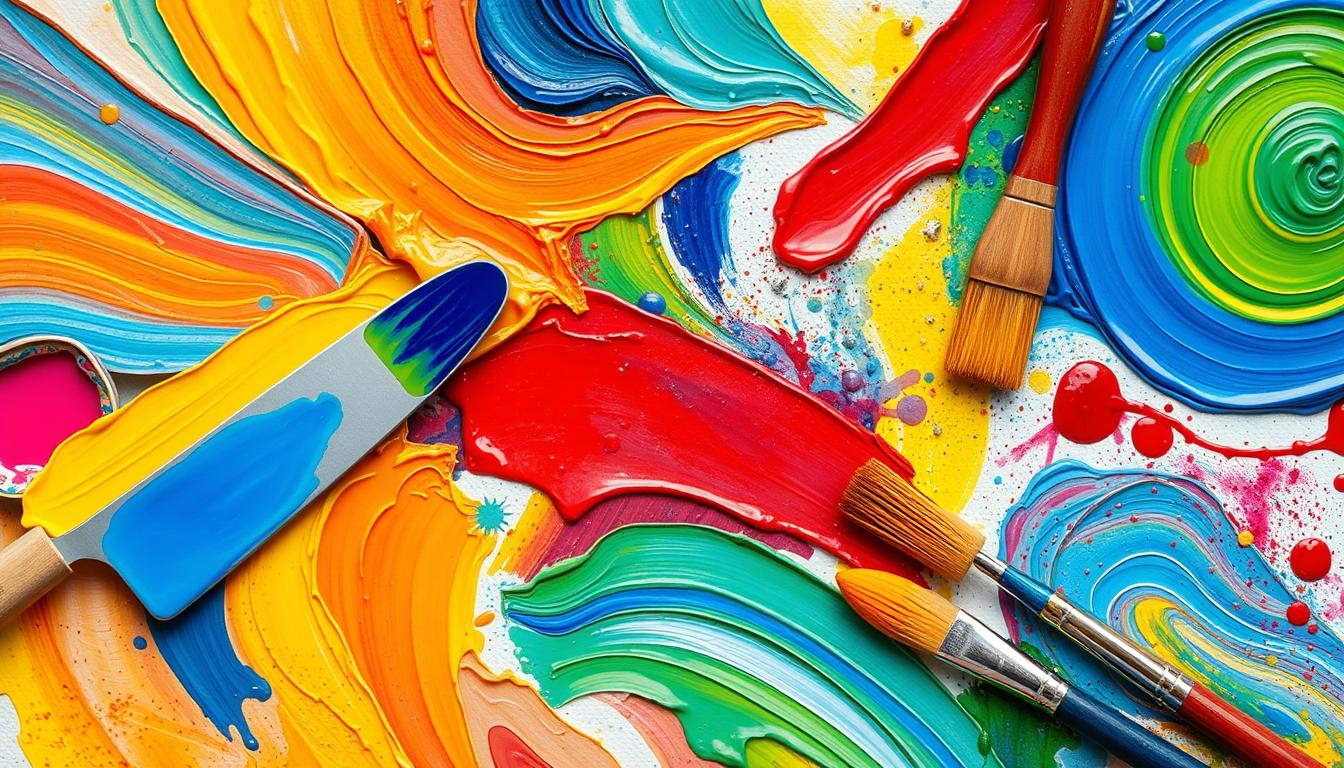This post contains affiliate links.
As an artist, I’ve always loved the vibrant world of acrylic paints. These paints can be layered and blended to create amazing visuals. But blending colors smoothly is one of the biggest challenges.
Don’t worry if blending colors is hard for you. This article will show you how to blend acrylic paints easily. We’ll cover wet-on-wet techniques and acrylic glazing. These methods will make your canvas paintings look amazing. So, let’s start and learn how to blend acrylic paints like a pro!
Key Takeaways
- Understand the essential materials and tools for acrylic paint blending
- Discover the secrets of wet-on-wet blending for seamless color transitions
- Explore the power of acrylic glazing to create depth and vibrant effects
- Learn how to blend acrylics on canvas using various techniques
- Gain confidence in your ability to create stunning, layered artworks
Introduction to Acrylic Paint Blending
Acrylic paint blending is a key skill for artists. It helps create smooth color transitions and striking backgrounds. To start, you’ll need acrylic paints, a flat brush, and a palette.
By blending colors on the canvas, you can make many effects. This includes realistic skies and abstract art. It’s a great way to add depth to your work.
Why Blending is an Essential Technique
Learning to blend acrylic paints is vital for artists. It makes colors flow smoothly, adding depth and realism. Whether you’re painting landscapes or portraits, blending is crucial.
The ability to blend acrylic paints effectively is a game-changer. It can transform your artwork.
Materials Needed for Acrylic Paint Blending
- Acrylic paints in various colors, including primary, secondary, and tertiary
- A flat wash brush for blending large areas
- A palette or mixing surface, like a disposable plate or plastic palette
- Water, retarder, and wetting agent for blending
- A canvas or primed surface to paint on
With these materials, you’ll be ready to master acrylic paint blending. You’ll open up a world of creative possibilities.
“Blending is the key to creating seamless, professional-looking paintings in acrylic. It takes practice, but the results are worth it.”
Wet-on-Wet Blending Techniques
Wet-on-wet, or “alla prima” blending, is a favorite among artists. It involves mixing colors on the canvas while the paint is still wet. This method is great for creating beautiful wet-on-wet acrylic blending and blending acrylic paints for skies and backgrounds.
Horizontal Wet-on-Wet Blending
The horizontal blending acrylics technique is perfect for creating stunning sky and background gradients. By painting in a horizontal direction, you can make smooth color transitions. This mimics the natural beauty of sunsets, oceans, and landscapes.
This technique adds depth and atmosphere to your artwork.
Circular Wet-on-Wet Blending
The circular blending acrylics method is great for creating vibrant, abstract effects. Painting in a circular motion produces a mesmerizing blend of colors. This adds vibrancy and dynamism to your paintings.

“Wet-on-wet blending is a game-changer for creating seamless color transitions and atmospheric effects in acrylic paintings.”
Whether you’re painting a serene landscape or an abstract masterpiece, wet-on-wet techniques are inspiring. They open up endless possibilities with acrylic paints.
Acrylic Glazing Blending Technique
Try acrylic glazing blending for a unique look. It involves adding a transparent paint layer over a base color. This method creates soft, hazy colors.
It’s great for beginners because it dries slowly. This slow drying lets you control the blending better.
To use this technique, you need a few things. You’ll need glazing medium, transparent acrylic paints, and a brush. The glazing medium makes colors look like stained glass. The transparent paints let you layer colors and textures.
“Glazing is a powerful technique that allows you to add depth, luminosity, and a sense of atmosphere to your paintings.”
For good results, apply glazes thinly and evenly. Let each layer dry before adding the next. This builds up color and transparency, making your paintings look amazing.
Acrylic glazing blending opens up new creative paths. It lets you using glazing medium for acrylic paint blending. This way, you can make your paintings more interesting and deep.
Double Wet-on-Wet Blending Technique
Discover the magic of double wet-on-wet blending for your acrylic paintings. It brings abstract backgrounds and striking two-toned effects to life. This method uses two colors on your brush to create a textured blend, unlike traditional gradients.
Mastering this technique starts with your brushwork. Begin by covering 1-2 inches of the canvas with the first color. Then, blend the second color into the first by moving your brush back and forth. Add more of the second color below the first, using broad strokes for blending. Finish with just the new color for a seamless look.
This blending method is perfect for abstract backgrounds or adding interest to your art. Try bold colors and unique brush patterns to create wet-on-wet two-toned effects that wow your viewers.

“Double wet-on-wet blending is a game-changer for artists looking to add depth, texture, and a touch of the unexpected to their acrylic paintings.”
Learning double load acrylic blending opens up a world of creativity. Embrace its fluidity and spontaneity to create abstract backgrounds with acrylic blending that take your art to new levels.
Wet-on-Dry Blending Technique
The wet-on-dry blending technique is a special way to mix acrylic paints. It’s different from the wet-on-wet method because you paint wet over dry paint. This method is great for beginners or those who want smooth color changes.
This technique is amazing for making blends and gradients. It’s slower than wet-on-wet, but you get more control. This is perfect for beginners or those who want precise color shifts.
To start, use a dark color as the base. This helps the lighter colors blend well. It makes your painting look stunning and balanced.
The blending wet paint on dry paint method is slower. But it’s worth it for the control it gives. It’s great for painting backgrounds, animal fur, shadows, and abstract scenes. It’s all about smooth color changes.
Whether you’re new or experienced with acrylics, this technique is key. It lets you explore new ways to paint. You can create creating smooth color transitions that grab the viewer’s attention.
Blending with Sponges and Palette Knives
Brushes are not the only way to blend acrylic paint. Sponges and palette knives can also create unique effects. Sponges work well for big areas, making colors blend softly. Palette knives are great for thick paint, leading to bold, abstract looks. Trying these tools can add new tricks to your art.
Sponge Blending for Large Surface Areas
Sponge blending is perfect for big canvases or surfaces. The sponge’s texture blends paint smoothly, making colors fade into each other. It’s great for big areas like skies or backgrounds, creating a seamless look.
Palette Knife Blending for Abstract Effects
Palette knives give acrylic paint a bold, abstract twist. The knife’s sharp edge lets you apply thick paint. Scraping and smearing with the knife creates dynamic effects. It’s ideal for artists who love a textured, expressive style.
Exploring sponges, palette knives, and other tools can really expand your art. Whether you want soft colors or bold abstracts, these methods can help. They unlock new ways to express yourself in acrylic paintings.
| Technique | Description | Suitable for |
|---|---|---|
| Sponge Blending | Using a sponge to apply and blend paint, creating soft, diffused transitions | Large surface areas, backgrounds, landscapes, skies |
| Palette Knife Blending | Applying and blending thicker, textured paint using the sharp edge of a palette knife | Abstract compositions, impasto effects, dynamic brushstrokes |
Half-Half Blending Technique
The half-half blending technique is a simple yet captivating way to blend acrylic paints on your canvas. You load one side of your brush with one color and the other with a contrasting hue. Then, you apply both shades at once to the surface. This creates visually striking, two-toned effects with minimal effort.
This simplified acrylic blending technique is perfect for beginners. It helps you practice color mixing and achieve smooth, half-half acrylic blending seamlessly. By mastering the half-half approach, you can explore a range of two-color blending techniques. You can also experiment with diverse color palettes to elevate your artistic expression.
- Load one side of your brush with the first paint color.
- Load the other side of the brush with a contrasting color.
- Apply the two colors side by side onto the canvas, blending them together as you paint.
- Adjust the paint consistency and pressure to achieve your desired level of blending and color integration.
- Experiment with different color combinations to create unique, two-toned effects.
| Blending Technique | Ideal for | Characteristics |
|---|---|---|
| Half-Half Blending | Creating two-toned effects, practicing color mixing | Simplified, minimal effort, versatile with color combinations |
“The half-half blending technique is a game-changer for beginners looking to explore the world of color in a tactile, hands-on way. It’s a simple yet powerful tool for unlocking your artistic potential.”
How to Blend Acrylic Paints on Canvas
Blending acrylic paints on canvas requires practice, but it’s achievable with the right techniques and patience. This guide will walk you through the blending process. You’ll learn about choosing the right brush size and paint consistency. Plus, you’ll discover various techniques for blending on canvas.
With practical tips for blending acrylic paint and visual examples, you’ll feel confident to apply these skills to your own canvas paintings.
Mastering the Blending Technique
This tutorial covers 8 acrylic paint blending techniques for beginners. The wet-on-wet blending technique is showcased with two methods: horizontal and circular. The acrylic glaze blending method is also introduced as a special way to blend paints.
The double wet-on-wet blending technique is great for abstract and two-toned effects. The wet-on-dry blending technique combines wet and dry paint for a unique result.
Using a sponge instead of a brush is suggested for large-scale blending. The palette knife blending technique is perfect for creating abstract art with thick paint.
Lastly, the half-half blending technique is an easy method to blend two colors with a large flat brush.
This tutorial invites everyone, from beginners to professionals, to try these 8 acrylic paint blending techniques. It’s a great way to improve your artistic skills on canvas.
Conclusion
In this guide, you’ve learned many acrylic paint blending techniques. You’ve seen everything from the wet-on-wet method to using sponges and palette knives. These methods can make your canvas paintings stand out, creating beautiful color combinations and opening up new artistic possibilities.
Remember, the more you practice, the better you’ll get. Don’t be shy to try new things and find what works best for you. Whether you’re just starting or have been painting for a while, learning to blend acrylic paints can take your art to new heights.
Keep working on your skills and exploring what acrylic paints can do. The more you blend, the more you’ll see how powerful this medium is. It can bring a lot of joy and growth to your art.
FAQ
What are the essential materials needed for acrylic paint blending?
What is the wet-on-wet blending technique and how can it be used?
How can acrylic glazing medium be used for blending?
What is the double wet-on-wet blending technique and how does it differ from regular wet-on-wet blending?
How does the wet-on-dry blending technique work, and what are its benefits?
What alternative tools can be used for acrylic paint blending?
What is the half-half blending technique, and how can it be used effectively?
This post contains affiliate links.

